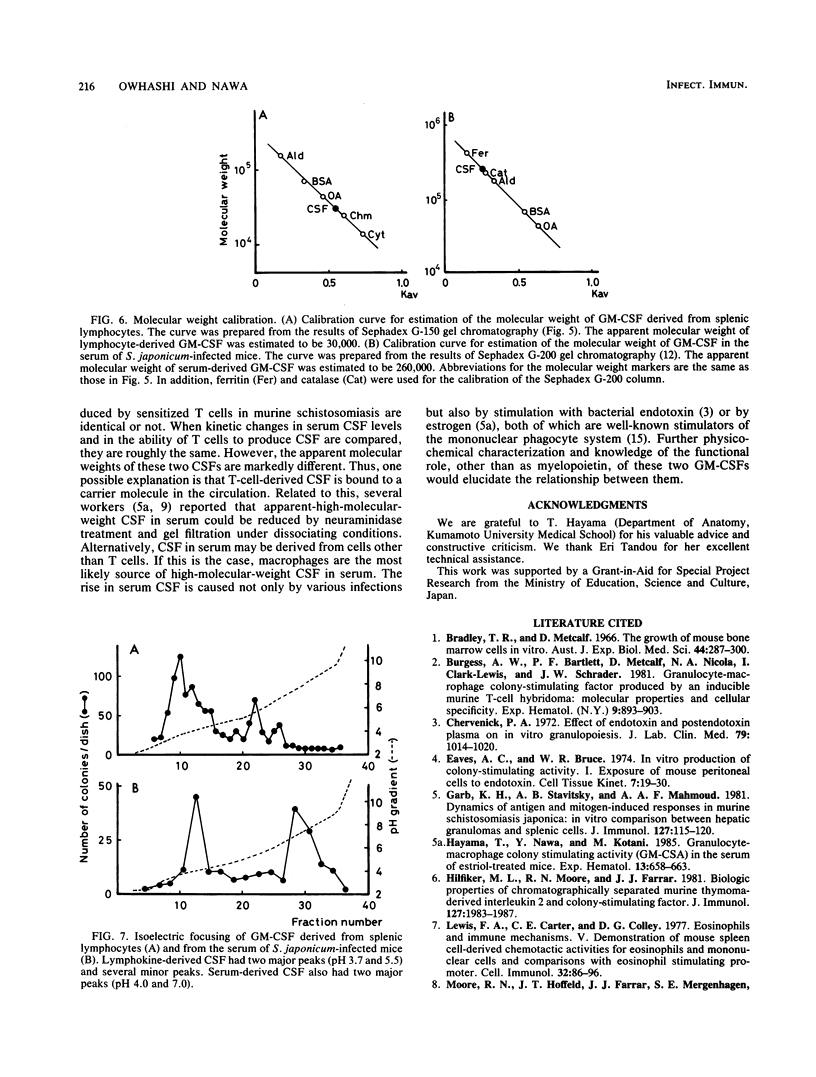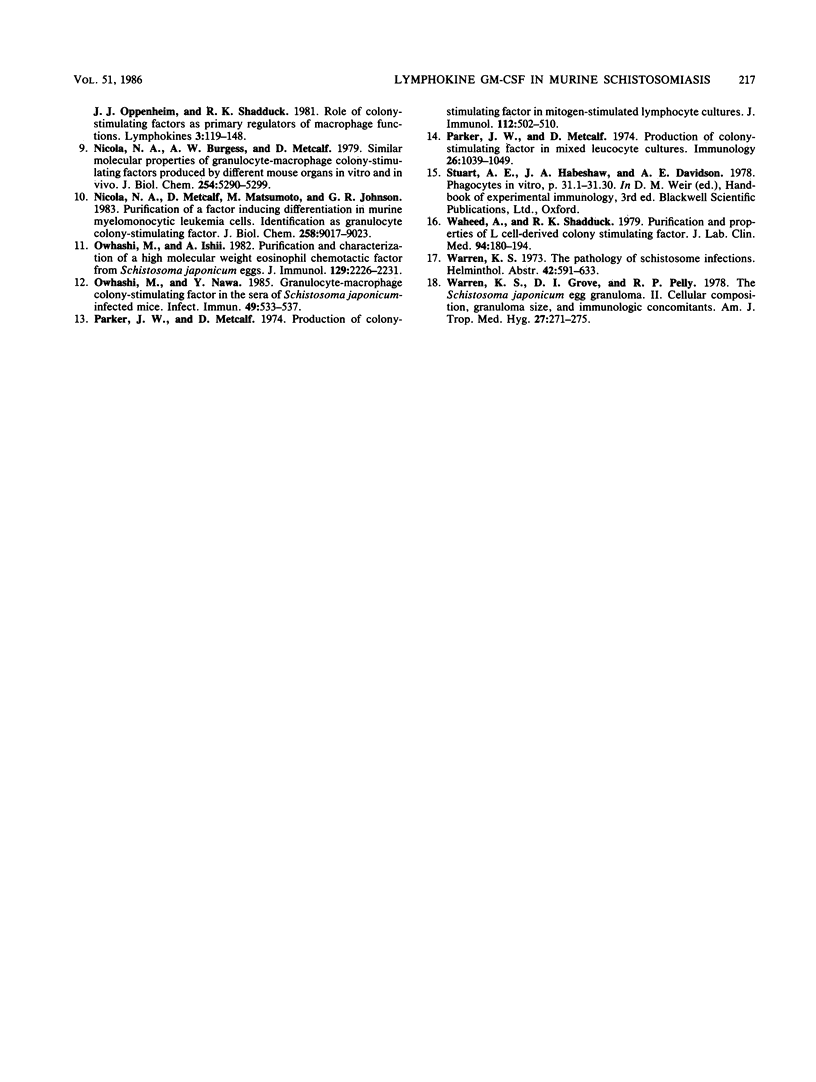Abstract
The production of granulocyte-macrophage (GM) colony-stimulating factor (CSF) by splenic lymphocytes was examined in murine schistosomiasis japonica. When splenic lymphocytes obtained at various weeks after infection were cultured with soluble egg antigen, GM-CSF activity in the conditioned medium became detectable at 3 weeks after infection, reached a peak at week 5, and persisted at least up to week 7. Not only soluble egg antigen but also concanavalin A was highly effective in stimulating splenic lymphocytes to produce GM-CSF. When splenic lymphocytes were treated with anti-Thy-1.2 antibody and complement, GM-CSF-producing activity was completely abolished. The molecular weight of this T-cell-derived GM-CSF was estimated to be 30,000 by gel filtration on Sephadex G-150. After isoelectric focusing, GM-CSF activity was detected as two major peaks at pH 3.7 and 5.5. The physicochemical nature of this T-cell-derived GM-CSF was compared with those of known lymphokine GM-CSFs or with that of a previously reported GM-CSF in the serum of S. japonicum-infected mice (M. Owhashi and Y. Nawa, Infect. Immun. 49: 533-537, 1985).
Full text
PDF




Selected References
These references are in PubMed. This may not be the complete list of references from this article.
- Bradley T. R., Metcalf D. The growth of mouse bone marrow cells in vitro. Aust J Exp Biol Med Sci. 1966 Jun;44(3):287–299. doi: 10.1038/icb.1966.28. [DOI] [PubMed] [Google Scholar]
- Burgess A. W., Bartlett P. F., Metcalf D., Nicola N. A., Clark-Lewis I., Schrader J. W. Granulocyte-macrophage colony-stimulating factor produced by an inducible murine T-cell hybridoma: molecular properties and cellular specificity. Exp Hematol. 1981 Oct;9(9):893–903. [PubMed] [Google Scholar]
- Chervenick P. A. Effect of endotoxin and postendotoxin plasma on in vitro granulopoiesis. J Lab Clin Med. 1972 Jun;79(6):1014–1020. [PubMed] [Google Scholar]
- Eaves A. C., Bruce W. R. In vitro production of colony-stimulating activity. I. Exposure of mouse peritoneal cells to endotoxin. Cell Tissue Kinet. 1974 Jan;7(1):19–30. doi: 10.1111/j.1365-2184.1974.tb00395.x. [DOI] [PubMed] [Google Scholar]
- Garb K. S., Stavitsky A. B., Mahmoud A. A. Dynamics of antigen and mitogen-induced responses in murine schistosomiasis japonica: in vitro comparison between hepatic granulomas and splenic cells. J Immunol. 1981 Jul;127(1):115–120. [PubMed] [Google Scholar]
- Hayama T., Nawa Y., Kotani M. Granulocyte-macrophage colony-stimulating activity in the serum of estriol-treated mice. Exp Hematol. 1985 Aug;13(7):658–663. [PubMed] [Google Scholar]
- Hilfiker M. L., Moore R. N., Farrar J. J. Biologic properties of chromatographically separated murine thymoma-derived Interleukin 2 and colony-stimulating factor. J Immunol. 1981 Nov;127(5):1983–1987. [PubMed] [Google Scholar]
- Nicola N. A., Burgess A. W., Metcalf D. Similar molecular properties of granulocyte-macrophage colony-stimulating factors produced by different mouse organs in vitro and in vivo. J Biol Chem. 1979 Jun 25;254(12):5290–5299. [PubMed] [Google Scholar]
- Nicola N. A., Metcalf D., Matsumoto M., Johnson G. R. Purification of a factor inducing differentiation in murine myelomonocytic leukemia cells. Identification as granulocyte colony-stimulating factor. J Biol Chem. 1983 Jul 25;258(14):9017–9023. [PubMed] [Google Scholar]
- Owhashi M., Ishii A. Purification and characterization of a high molecular weight eosinophil chemotactic factor from Schistosoma japonicum eggs. J Immunol. 1982 Nov;129(5):2226–2231. [PubMed] [Google Scholar]
- Owhashi M., Nawa Y. Granulocyte-macrophage colony-stimulating factor in the sera of Schistosoma japonicum-infected mice. Infect Immun. 1985 Sep;49(3):533–537. doi: 10.1128/iai.49.3.533-537.1985. [DOI] [PMC free article] [PubMed] [Google Scholar]
- Parker J. W., Metcalf D. Production of colony-stimulating factor in mitogen-stimulated lymphocyte cultures. J Immunol. 1974 Feb;112(2):502–510. [PubMed] [Google Scholar]
- Parker J. W., Metcalf D. Production of colony-stimulating factor in mixed leucocyte cultures. Immunology. 1974 May;26(5):1039–1049. [PMC free article] [PubMed] [Google Scholar]
- Waheed A., Shadduck R. K. Purification and properties of L cell-derived colony-stimulating factor. J Lab Clin Med. 1979 Jul;94(1):180–193. [PubMed] [Google Scholar]
- Warren K. S., Grove D. I., Pelley R. P. The Schistosoma japonicum egg granuloma. II. Cellular composition, granuloma size, and immunologic concomitants. Am J Trop Med Hyg. 1978 Mar;27(2 Pt 1):271–275. doi: 10.4269/ajtmh.1978.27.271. [DOI] [PubMed] [Google Scholar]


